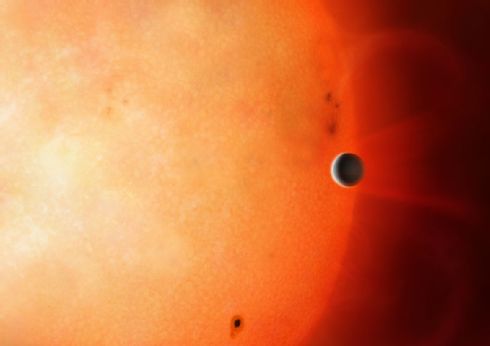This 'hot Jupiter' alien planet is dancing with death with its 18-hour year
It's destined to be torn apart by its parent star.

A newly found exoplanet orbits so close to its parent star that it's close to being torn apart by the tidal forces induced by gravity.
The recently discovered exoplanet NGTS-10b whips around its star in just over 18 hours, making it the shortest orbital period ever observed for a "hot Jupiter" – a large, gassy exoplanet that travels close to the heat of a star. It whirls so close to its star, about 27 times closer to its star than the planet Mercury is to our sun, that it's dangerously close to falling apart.
Scientists found the strange world (which is about 20% larger than Jupiter and twice as massive) about 1,000 light-years from Earth. It popped up in data from the Next-Generation Transit Survey – a Chilean exoplanet survey that looks for large planets. NGTS-10b was found using the transit method, which detects planets when they pass (or transit) in front of their stars, obscuring a tiny part of the star's brightness.
Related: The Strangest Alien Planets in Pictures
More: Extremely Hot and Incredibly Close: How Hot Jupiters Defy Theory
"In theory, hot Jupiters with short orbital periods – less than 24 hours – are the easiest [planets] to detect due to their large size and frequent transits," lead author James McCormac, a physicist at the University of Warwick in the U.K., said in a statement. "[But] they have proven to be extremely rare. Of the hundreds of hot Jupiters currently known, there are only seven that have an orbital period of less than one day."
NGTS-10b's star is about 70 percent the mass of our sun, but because the two are so close together, the exoplanet experiences temperature extremes on its surface due to its closeness. One side of the planet is perpetually locked to the star, with a scorching surface temperature of about 1,830 degrees Fahrenheit (1,000 degrees Celsius).
Get the Space.com Newsletter
Breaking space news, the latest updates on rocket launches, skywatching events and more!
The discovery team speculated that NGTS-10b could be an ideal candidate for future study with NASA's James Webb Space Telescope, which is expected to launch in March 2021. One of Webb's science missions is to uncover more about planetary atmospheres, and with that data scientists hope to see how exoplanet atmospheres behave in such strange temperature extremes.
Since gas giant planets usually form far away from their star and migrate inward, the team plans to conduct follow-up observations within the next decade to see if NGTS-10b is in a death spiral, or in a more stable orbit.
A paper based on the discovery was published in the Monthly Notices of the Royal Astronomical Society on Feb. 20.
- Giant 'Hot Jupiters' May Grow Even Larger with Age
- Why 'Hot Jupiter' Exoplanets Aren't Eaten by Their Stars
- The Strangest Alien Planets (Gallery)
Follow Elizabeth Howell on Twitter @howellspace. Follow us on Twitter @Spacedotcom and on Facebook.
OFFER: Save at least 56% with our latest magazine deal!
All About Space magazine takes you on an awe-inspiring journey through our solar system and beyond, from the amazing technology and spacecraft that enables humanity to venture into orbit, to the complexities of space science.
Join our Space Forums to keep talking space on the latest missions, night sky and more! And if you have a news tip, correction or comment, let us know at: community@space.com.

Elizabeth Howell (she/her), Ph.D., was a staff writer in the spaceflight channel between 2022 and 2024 specializing in Canadian space news. She was contributing writer for Space.com for 10 years from 2012 to 2024. Elizabeth's reporting includes multiple exclusives with the White House, leading world coverage about a lost-and-found space tomato on the International Space Station, witnessing five human spaceflight launches on two continents, flying parabolic, working inside a spacesuit, and participating in a simulated Mars mission. Her latest book, "Why Am I Taller?" (ECW Press, 2022) is co-written with astronaut Dave Williams.
-
rod ReplyAdmin said:A newly found planet orbits so close to its parent star that it's close to being torn apart by the tidal forces induced by gravity.
This 'hot jupiter' alien planet is dancing with death with its 18-hour year : Read more
Another interesting exoplanet report and hot Jupiter type. The MNRAS abstract states "NGTS-10b orbits its host at just 1.46 ± 0.18 Roche radii, and we calculate a median remaining inspiral time of 38 Myr and a potentially measurable orbital period decay of 7 s over the coming decade, assuming a stellar tidal quality factor Q′sQs′ =2 \00d7 10^7."
An orbital decay rate of 7 seconds over the next ten years and spiral into the parent star in 38E+6 years. Here is some more stats on NGTS-10b exoplanet, Planet NGTS-10 b The host star age is shown as 10.4E+9 years old, a smaller K5V main sequence star. The current orbit measurements suggests the exoplanet will die in 38E+6 years, falling into the host star, yet the host star can be older than 10E+9 years old. If the exoplanet formed in situ, there is a serious age problem with the H-R diagram age. The exoplanet could be rotating on its axis like Jupiter too, perhaps 10 hour period or close to 15.7 km/s because it has a larger diameter than Jupiter too. Exoplanet research is getting very interesting.

